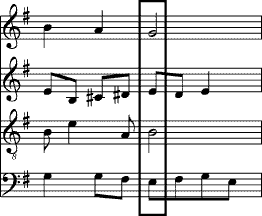Copyright © 2004 Society for Music Theory
4.1 “Composed” Triads
[1] Our analyses used large samples of triads drawn from the chorale harmonizations of Bach and the string quartets of Haydn and Mozart. The following guidelines formed the basis of our procedures for sampling triads.
- Four-voice sonorities in the home-key regions
- were searched to find complete triads
- at strong metrical positions.
- A triad was discarded if any pair of voices approached or departed the triad using parallel motion at the octave, or if two voices met or crossed.
- We did not attempt to identify triads below the musical surface.
[2] In order to increase the size of our sample, we made use of computer software to automate the analysis and sampling of music. In order to turn the process over to a computer, it was necessary to operationalize some basic musical definitions, in particular:
- where are tonal centers unambiguous (see §4.1.1); and
- what is a strong metrical position, and is a triad a triad without one? (See §4.1.2.)
[3] The sampling process benefited immensely from the use of existing resources, particularly electronic scores and computer analysis software. All of the scores were taken from the MuseData database created by CCARH,(71) and were analyzed using both the Humdrum Toolkit(72) and the Melisma harmonic analysis software.(73)
[4] The complete process resulted in a total sample of 2643 triads from the chorales, and 960 triads from the string quartets. Some triads taken randomly from the sample are shown in Figure 4.1a.
Figure 4.1a. Some triads taken at random from the sample:
|
1. |
2. |
3. |
4. |
|
Go on to §4.1.1 (Tonal Context) ► |
Copyright Statement
Copyright © 2004 by the Society for Music Theory. All rights reserved.
[1] Copyrights for individual items published in Music Theory Online (MTO) are held by their authors. Items appearing in MTO may be saved and stored in electronic or paper form, and may be shared among individuals for purposes of scholarly research or discussion, but may not be republished in any form, electronic or print, without prior, written permission from the author(s), and advance notification of the editors of MTO.
[2] Any redistributed form of items published in MTO must include the following information in a form appropriate to the medium in which the items are to appear:
This item appeared in Music Theory Online in [VOLUME #, ISSUE #] on [DAY/MONTH/YEAR]. It was authored by [FULL NAME, EMAIL ADDRESS], with whose written permission it is reprinted here.
[3] Libraries may archive issues of MTO in electronic or paper form for public access so long as each issue is stored in its entirety, and no access fee is charged. Exceptions to these requirements must be approved in writing by the editors of MTO, who will act in accordance with the decisions of the Society for Music Theory.
This document and all portions thereof are protected by U.S. and international copyright laws. Material contained herein may be copied and/or distributed for research purposes only.
Prepared by Brent Yorgason, Managing Editor and Tahirih Motazedian, Editorial Assistant

